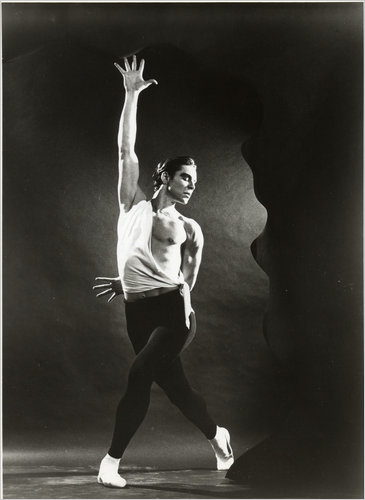Groundbreaking ballet dancer Jacques d’Amboise, who created memorable roles in works by Balanchine and other stars of ballet’s American golden age, will be in Portland on Thursday, April 14, to talk about his new book I Was a Dancer. D’Amboise also choreographed for Balanchine’s New York City Ballet, and appeared in dancing roles in the movie-musical classics Seven Brides for Seven Brothers and Carousel. Art Scatter’s chief correspondent, Martha Ullman West, will introduce him before his talk at the Portland Ballet Studio. Come hear ’em both — and read what Martha has to say about d’Amboise below.
By Martha Ullman West
Writing about dancing ain’t easy, as you’ve all heard me say more than once. Like visual arts and music, this is non-verbal communication, and, to paraphrase William Butler Yeats, people dance to say the things there are no words for.
 Few dancers are as capable of eloquence with words as they are with their bodies, but there are exceptions. Jacques d’Amboise, one of this country’s first homegrown great male ballet dancers, is one of them, and he’ll be in town to talk about his new book, I Was a Dancer, this Thursday, April 14, at the Portland Ballet Studio. (6250 SW Capitol Highway, 7:30-9 pm, for reservations call 503-452-8448.)
Few dancers are as capable of eloquence with words as they are with their bodies, but there are exceptions. Jacques d’Amboise, one of this country’s first homegrown great male ballet dancers, is one of them, and he’ll be in town to talk about his new book, I Was a Dancer, this Thursday, April 14, at the Portland Ballet Studio. (6250 SW Capitol Highway, 7:30-9 pm, for reservations call 503-452-8448.)
I’ll introduce him, briefly. Then he’ll read from the book, show some clips from the superb DVD Jacques d’Amboise, Portrait of a Great American Dancer, take some questions from the audience and sign some books, which thanks to Annie Bloom’s Books, will be available for purchase at the studio.
Judging from the way d’Amboise performed his duties as master of ceremonies at Todd Bolender‘s memorial five years ago in Kansas City, I Was a Dancer is a tad misleading as a title: the man is incapable of standing still and talking, although he certainly has the gift of the gab (his father was Irish-American, which may account for it; his mother was a French Canadian who insisted the family change the name to hers, d’Amboise, because it was classier than Ahearn). At the celebration of Bolender’s life, d’Amboise was all over the stage reciting a poem, doing a kind of rap he may have learned from the New York City public school kids he’s been teaching to dance for several decades at his National Dance Institute, which is now a worldwide operation.
With that program, d’Amboise is giving back. He was something of a street kid on New York’s Upper West Side, but he was taking ballet classes at Balanchine’s School of American Ballet on scholarship when a rumble, so to speak, scared the hell out of him, and at 15 he left high school to join New York City Ballet in its early days at City Center. At 12 he was watching, avidly, the performances of Ballet Society, NYCB’s forerunner, where he became a huge admirer of Bolender, describing him in the role of Phlegmatic in Balanchine’s Four Temperaments thus: “… at one moment, [he] leans over and in slow motion wraps his right hand around his ankle as if it were a snake slithering around the stem of a flowering plant.” He recalled Tanaquil LeClercq‘s performance in Choleric in the same ballet as “flaying her mile-long limbs in a circle, reminding me of [his mother’s] eggbeater whipping heavy cream.”
 The book is episodic, and sometimes hard to follow as the author’s active mind jumps from memory to memory in Joycean fashion. Yet it’s a wonderful read, highly evocative of New York in the nineteen forties and fifties, when I, too, was growing up there, and watching d’Amboise and his colleagues from the cheapest seats in the second balcony at City Center. He can be extremely funny — his account of making a novena so God will give him superpowers and enable him to fly is hilarious. And he can tug at your heartstrings as he writes about LeClercq felled by polio, or his conversation with Melissa Hayden, his long-time dancing partner and friend, on her deathbed in 2006, the same year Bolender made his final exit.
The book is episodic, and sometimes hard to follow as the author’s active mind jumps from memory to memory in Joycean fashion. Yet it’s a wonderful read, highly evocative of New York in the nineteen forties and fifties, when I, too, was growing up there, and watching d’Amboise and his colleagues from the cheapest seats in the second balcony at City Center. He can be extremely funny — his account of making a novena so God will give him superpowers and enable him to fly is hilarious. And he can tug at your heartstrings as he writes about LeClercq felled by polio, or his conversation with Melissa Hayden, his long-time dancing partner and friend, on her deathbed in 2006, the same year Bolender made his final exit.
It’s a good book, a good read, a love story on many levels. And it will be fun at the very least on Thursday to watch d’Amboise, who is, and I suspect will be until he breathes his last, a dancer.
*
Photo: Jacques d’Amboise in “Apollo.” Courtesy New York City Ballet.